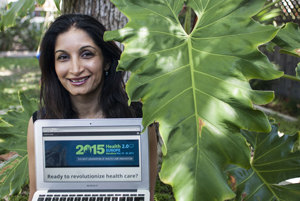When Indu Subaiya was finishing medical school and chose to forgo further training in favor of becoming a businesswoman, most people thought it was career suicide.
“It was seen almost as a failure,” Subaiya said of the decision she made not to do a residency in 1999 while at Stony Brook University’s school of medicine in New York. “‘What are you doing throwing away this incredible opportunity?’ There was almost like a fear and a concern what you were going to do with yourself and your career.”
Her Indian father joked that if nothing else, Subaiya could drive a cab.
Instead, she moved to San Francisco and consulted for a boutique health care consulting firm, where she helped biotech and pharma companies commercialize their products. Though Subaiya already had a graduate education, she returned to school to get an M.B.A. at UC Berkeley.
She is among an increasing number of doctors and would-be doctors who decided to pursue business degrees, helped in part by a sharp increase in dual M.D.-M.B.A. programs cropping up around the nation. Some are motivated by frustration that paperwork duties for doctors today outweigh patient face time. Others want to mold medical reforms on a larger scale and need more entrepreneurial skills.
After graduation, she co-founded Health 2.0. The firm hosts global conferences promoting companies that use technology to improve health care, and it provides market intelligence for the industry. While Health 2.0 is based in the Bay Area, Subaiya lives in Los Feliz and her 13 employees are spread throughout the country.
“Fast-forward a decade and the opportunities for physicians or people with a clinical background outside of practicing medicine have grown exponentially,” Subaiya said.
Dual M.D.-M.B.A. offerings in the United States have grown from about five programs in 1993 to 65 in 2012, according to the Journal of the Association of American Medical Colleges. That means they’re offered at about half of the country’s accredited medical schools, including UCLA and USC.
MCAT to GMAT
Downward pressure on physician salaries and increasing consolidation have made it harder to survive as a lone practitioner.
The Journal of the American Medical Association reported that median earnings for physicians in 2010 were $157,751, up only 9.6 percent from the $143,963 median in 1987. In the same period, other health professionals saw much larger growth in earnings: pharmacists’ earnings increased 44 percent.
Against that backdrop, gaining business acumen is appealing. Others see a convergence of mandated health care reform and more readily available consumer technology as a tremendous opportunity. The only thing they need are entrepreneurial chops.
Like Subaiya, Rania Nasis decided against a residency as she was finishing her medical degree at New Jersey Medical School in 2007, now part of Rutgers University.
“I looked around and saw unhappy doctors, who spent most of the time writing down notes, dealing with insurance, a lot of paperwork and very little time interacting with patients,” Nasis said of her last two years in school when she spent time working at a hospital. “They went into medicine to help people and spent so little time interacting with patients.”
Nasis, who came from a family of entrepreneurs, always had a love of business and saw a lot of opportunities to apply her medical knowledge in a more enterprising way.
After graduation, she dove back into school to get her M.B.A. from UC Irvine in 2009. Nasis then landed at Irvine biotech startup California Stem Cell Inc., where her dual background was a real boon.
Since then, she’s consulted in regenerative medicine and worked in health care financing. Nasis is now working on launching a West L.A. startup dealing with the investment industry as it relates to health care.
In her spare time, she runs the two-year-old L.A. chapter of the Society of Physician Entrepreneurs. The group facilitates networking and education among doctors, entrepreneurs, engineers and others interested in health care.
“The public perception is that doctors are making a lot because there’s a lot of demand,” said Nasis, explaining that’s not necessarily the case when you take into account all the overhead from bill collecting, insurance and paperwork. “A lot are choosing to work for hospitals where there’s a demand to see 20 to 25 patients a day or more.”
Bigger scale
Some entrepreneurial physicians want to tackle some of these day-to-day frustrations, find ways to improve patient care and solve large-scale problems.
“I think doctors have all the entrepreneurial skills, I just don’t think they’re afforded the opportunity,” said Kourosh Parsapour, a pediatrician with more than 15 years of experience in emergency and critical care who went back to school part time to get his M.B.A. from UC Irvine in 2012. He sees many overlapping qualities between physicians and entrepreneurs.
“When we decide to give a medicine or therapy, you evaluate the patient, make an assessment of what they need, give them the intervention, monitor the response and adjust accordingly,” Parsapour said. “It’s exactly what you do with a new product: evaluate the market, see a need and put out your minimum viable product.”
Granted, physician training can also mute some more entrepreneurial behaviors. Failure, for example, is frowned upon in medical training but embraced in the entrepreneurial community, explained Parsapour, who’s now chief executive of Hermosa Beach’s PersonalRN, which makes customizable mobile apps for patients.
“It’s good to fail and learn from your mistakes,” he said.

